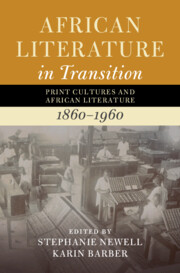Book contents
- African Literature in Transition
- African Literature in Transition
- African Literature in Transition
- Copyright page
- Contents
- Figures
- Tables
- Contributors
- Introduction
- Part I Producing Print
- Part II Readers and Audiences
- Part III New Genres
- Chapter 11 Linguistic Cohabitation and the Equivalences of Print
- Chapter 12 Autoethnographic Expression and the Politics of Educational Adaptation
- Chapter 13 Satirical Street Literature
- Chapter 14 Pioneers of the Popular
- Chapter 15 Orthographic Arguments
- Chapter 16 ‘Usefully Unofficial’ Reading
- Part IV Worlds of Print
- Index
- References
Chapter 15 - Orthographic Arguments
Language Debates in Swati Newspapers of the 1950s and 1960s
from Part III - New Genres
Published online by Cambridge University Press: 23 October 2025
- African Literature in Transition
- African Literature in Transition
- African Literature in Transition
- Copyright page
- Contents
- Figures
- Tables
- Contributors
- Introduction
- Part I Producing Print
- Part II Readers and Audiences
- Part III New Genres
- Chapter 11 Linguistic Cohabitation and the Equivalences of Print
- Chapter 12 Autoethnographic Expression and the Politics of Educational Adaptation
- Chapter 13 Satirical Street Literature
- Chapter 14 Pioneers of the Popular
- Chapter 15 Orthographic Arguments
- Chapter 16 ‘Usefully Unofficial’ Reading
- Part IV Worlds of Print
- Index
- References
Summary
African newspapers could be important conduits for debates around language and identity; more than that, newspapers were often the very crucible through which new African languages emerged. This chapter tells the twentieth-century story of the emergence of a codified written form of siSwati, the vernacular language of Eswatini (formerly Swaziland). Yet the appearance of siSwati was far from straightforward, and it appeared relatively late in the day, only around the 1960s. Earlier Swati intellectuals had largely used the language of neighbouring South Africa – isiZulu – for their print innovations. By the 1950s, a new interest in a written form of siSwati emerged in step with nationalist aspirations. Yet evidence from African-language newspapers shows us that the development of siSwati was fraught, dissent-filled, and uneven. The periodic and decentralized nature of the mid-century African newspaper made these kinds of debates possible, reminding us of the important orthographic work accomplished by print periodicals.
Information
- Type
- Chapter
- Information
- African Literature in TransitionPrint Cultures and African Literature, 1860–1960, pp. 294 - 312Publisher: Cambridge University PressPrint publication year: 2025
References
Accessibility standard: Inaccessible, or known limited accessibility
Why this information is here
This section outlines the accessibility features of this content - including support for screen readers, full keyboard navigation and high-contrast display options. This may not be relevant for you.Accessibility Information
Content Navigation
Allows you to navigate directly to chapters, sections, or non‐text items through a linked table of contents, reducing the need for extensive scrolling.
Provides an interactive index, letting you go straight to where a term or subject appears in the text without manual searching.
Reading Order & Textual Equivalents
You will encounter all content (including footnotes, captions, etc.) in a clear, sequential flow, making it easier to follow with assistive tools like screen readers.
You get concise descriptions (for images, charts, or media clips), ensuring you do not miss crucial information when visual or audio elements are not accessible.
You get more than just short alt text: you have comprehensive text equivalents, transcripts, captions, or audio descriptions for substantial non‐text content, which is especially helpful for complex visuals or multimedia.
Visual Accessibility
You will still understand key ideas or prompts without relying solely on colour, which is especially helpful if you have colour vision deficiencies.
You benefit from high‐contrast text, which improves legibility if you have low vision or if you are reading in less‐than‐ideal lighting conditions.
